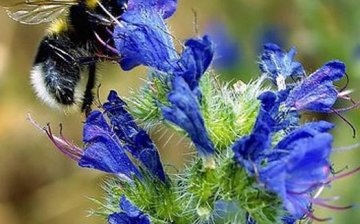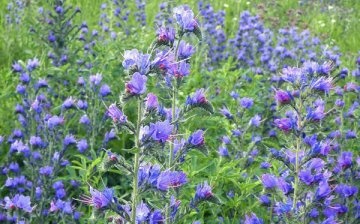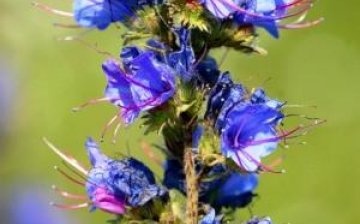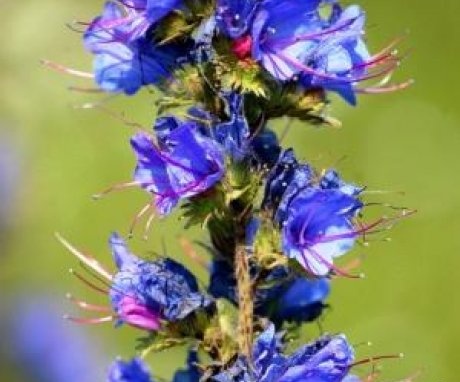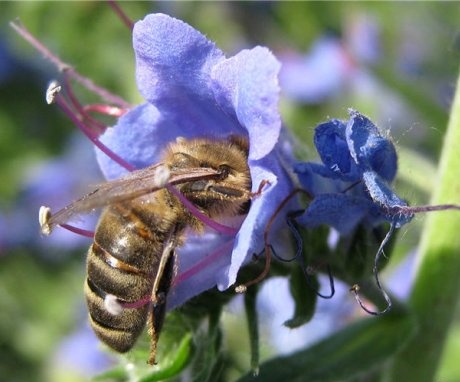Bruise honey plant and its cultivation
The bruise honey plant is very popular among experienced beekeepers. After all, the flowers of this plant secrete fragrant nectar, to which honey bees willingly flock.
Content:
- Characteristic features of an ordinary bruise
- Growing an ordinary bruise
- Useful properties of common bruise
Characteristic features of an ordinary bruise
So what does the bruise plant itself look like? How to visually recognize it?
Common bruise (Latin Echium vulgare) belongs to the borage family. It is a biennial plant, the height of which reaches 180 cm.
You will see the first inflorescences only in the second year after sowing the seeds. Flowers are collected on elongated peduncles in curls. Moreover, at first they have a pink tint, which eventually turns into a bright blue. Flowers with a diameter of about 2.5 cm are bell-shaped.
The plant is completely covered with long, fluffy and rather tough spines that retain moisture in the leaves.
Blooming of a bruise begins in June and lasts until the first frost. On one stem, a bruise can develop up to 1500 flowers over the entire flowering season, each of which blooms for two days and is able to release up to 16 mg of nectar.
The nectar is in the flower only when it has a pink tint, and when the flowers turn blue, then there is no nectar in them. The nectar is not washed out of the flower by rains and does not evaporate in dry weather, which makes the bruise a very valuable honey plant.
Bruise grows naturally in the steppes, dry meadows, rocky places. The plant is so unpretentious that it can be seen both on the roadsides and in the littered areas.
As a biennial plant, the bruise grows in the territories of Russia, Ukraine, Belarus, Moldova, and as a perennial - in warm regions, such as the Mediterranean countries.
Growing an ordinary bruise
Choosing the time for sowing seeds bruise, you need to know the climatic conditions of your region very well. If you plant seeds in the fall, then you need to do this literally before the onset of severe frosts. Otherwise, still fragile seedlings may appear, which will simply die due to frost. If you are not ready to take such a risk, then sowing a bruise should be carried out in late spring or early July so that it can get stronger and successfully overwinter.
The bruise loves open, sunny places, but to soils undemanding. And yet, for a more intense flowering, it is better to grow it on loose and fertile soil with neutral or slightly alkaline indicators.
Sow a bruise on the prepared soil with a grass seeder or simply with your hands. The plant does not require a special sowing density: about 5 kg of seeds will be required per hectare. The planting depth is from 1 to 3 cm. Seeds germinate at a temperature of +10 degrees, and the most optimal temperature for plant growth and flowering is from +20 to +28 degrees.
The bruise does not need cultivation or any special agrotechnical measures. But if the soil under the plants fertilize with organic fertilization, the plant will grow taller, and as a result, it will have more flowers on each stem.
Since the bruise is a two-year-old plant and does not bloom in the first year, annual honey plants are sown with it, such as phacelia... It blooms in the first year, and a bruise blooms in the second.Thus, a plantation is obtained for the annual collection of nectar by the bees.
The bruise is a drought-resistant plant species and does not need special watering. He is a competitor to other plants, displacing them. In the future, the bruise is sown by itself and annually blooms with continuous conveyor arrays.
Useful properties of common bruise
Bruise is in the top 10 of the largest honey plants, taking an honorable second place after linden. The honey productivity of a bruise is approximately 850 kg per hectare, while that of linden is up to 1000 kg. The rest of the herb-melliferous plants have a honey productivity 2-3 times less than a bruise or linden. Honey from bruise flowers is of high quality, has a light amber color, wonderful smell and pleasant taste.
For medicinal purposes, flowers and bruise leaves are used, which are harvested during the flowering period. Plants are dried in the shade outdoors or in well-ventilated areas.
The collected raw materials contain substances such as alkaloids, saponins, vitamin C and poisons, the action of which is equivalent to the action of curare poison.
A decoction of dried flowers and bruise leaves is used as an expectorant and sedative. For this, 1 dessert spoon of raw material is poured into 200 ml of water and boiled. The resulting broth is filtered and taken 2-3 times a day, 1/3 cup.
Bruise leaves are used externally in the form of compresses for rheumatism, arthritis, gout and tendon sprains. For these purposes, the leaves are boiled and applied to the sore spot.
The whole plant is quite poisonous, so it must be used with extreme caution, excluding an overdose.



